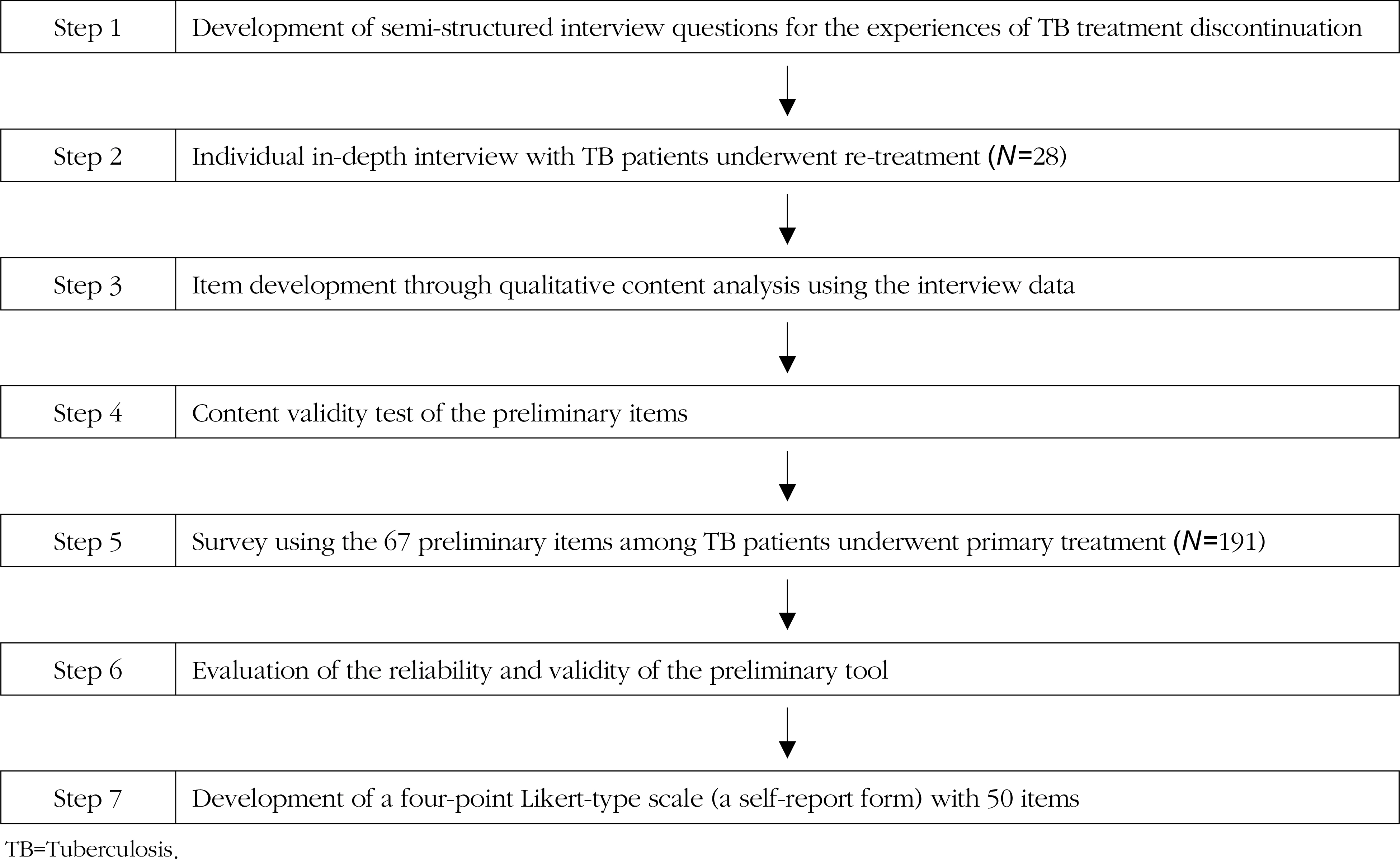Korean J Adult Nurs.
2015 Apr;27(2):156-169. 10.7475/kjan.2015.27.2.156.
The Development of a Scale Assessing the Risk of Discontinuation of Tuberculosis Treatment
- Affiliations
-
- 1Masan National Hospital, Masan, Korea.
- 2College of Nursing, Gyeongsang National University, Jinju, Korea. sung@gnu.ac.kr
- 3Institute of Health Sciences, Gyeongsang National University, Jinju, Korea.
- KMID: 2298130
- DOI: http://doi.org/10.7475/kjan.2015.27.2.156
Abstract
- PURPOSE
This study identified the reasons why tuberculosis (TB) patients withhold treatment in a bid to develop a assessment scale to select patients who needs nursing intervention in the early stage and decrease the risk of discontinuation of treatment. Sample: There were two samples. A sample of 191 patients with TB and having primary treatment and a second sample of N who were under re-treatment.
METHODS
The study design included qualitative and quantitative methods. Qualitative data were collected from in-depth interviews of TB patients under re-treatment. The quantitative data were collected from 191 patients with TB under primary treatment.
RESULTS
Exploratory factor analysis revealed 11 factors explaining 69.6% of total variance. These factors were categorized into four subgroups. A depression scale was used to establish concurrent validity. The depression scale had a positive relationship (r=54) with the discontinuing of primary treatment. The internal consistency reliability for the four subgroups was over .84. The confidence coefficient was Cronbach's alpha.95. The final scale was a self-reported four Likert scale including 50 items.
CONCLUSION
Reliability and validity was established for the scale and the scale can be used to examine the risk of treatment discontinuation for TB. The scale is an important resource for nursing interventions in identifying and treating high risk clients.
MeSH Terms
Figure
Reference
-
1.Lee HM. A study for medical facilities utilization patterns of tuberculosis patients and treatment success of tuberculosis in public health centers: by using the nationwide tuberculosis notification data [master's thesis]. Seoul: Hanyang University;2013.2.Statistics Korea. Cause of death statistics in 2013. Seoul: Statistics Korea;2014. [cited 2014 September 28]. Available from:. http://kostat.go.kr/portal/korea/kor_nw/3/index.board?bmode=read&aSeq=330183.3.Korea Centers for Disease Control and Prevention. A report for current registration statistics of patients with tuberculosis in 2013. Seoul: Korea Centers for Disease Control and Prevention;2014. [cited 2014 September 28]. Available from:. http://www.cdc.go.kr/CDC/intro/CdcKrIntro0201.jsp?menuIds=HOME001-MNU1154-MNU0005-MNU0011&cid=26973.4.Cheong CO., Kim SS., Kang MK., Cho EH., Lee EY., Chang CH. Knowledge and attitudes toward tuberculosis among high school students in Busan. Tuberculosis and Respiratory Diseases. 2008. 65(5):369–78.
Article5.Chang KS. A relationship of self-efficacy, social support, and therapeutic compliance in patients with tuberculosis [master's thesis]. Jeonnam: Chodang University;2010.6.Korea Centers for Disease Control and Prevention. National management guideline for patients with tuberculosis in 2011. Seoul: Korea Centers for Disease Control and Prevention;2013. [cited 2014 September 28]. Available from:. http://www.cdc.go.kr/CDC/notice/CdcKrTogether0302.jsp?menuIds=HOME001-MNU1154-MNU0004-MNU0088&cid=20376.7.Guo N., Marra F., Marra CA. Measuring health-related quality oflife in tuberculosis: a systematic review. HealthandQuality of Life Outcome. 2009. 7(14):);online.http://dx.doi.org/10.1186/1477-7525-7-14.
Article8.Kim HS., Ha CK. A study on family support, depression, and quality of life among patients with tuberculosis in a hospital: focusing onmediating effectofdepression. JournalofFamily Relations. 2010. 14(4):157–82.9.Rajeswari R., Muniyandi M., Balasubramanian R., Narayanan PR. Perceptions of tuberculosis patients about their physical, mental and social well-being: a field report from south India. Social Science & Medicine. 2005. 60:1845–53. http://dx.doi.org/10.1016/j.socscimed.2004.08.024.
Article10.Ugarte-Gil C., Ruiz P., Zamudio C., Canaza L., Otero L., Kruger H, et al. Association of major depressive episode with negative outcomes of tuberculosis treatment. 2013. 8(7):online. http://dx.doi.org/10.1371/journal.pone.0069514.11.Atif M., Sulaiman SAS., Shafie AA., Asif M., Sarfraz MK., Low HC, et al. Impact of tuberculosis treatment on health-related quality of life of pulmonary tuberculosis patients: a follow-up study. Health and Quality of Life Outcomes. 2014. 12(14):): online. http://dx.doi.org/10.1186/1477-7525-12-19.
Article12.Dimitrova B., Balabanova D., Atun R., Drobniewski F., Leviche-va V., Coker R. Health service providers' perceptions of barriers to tuberculosis care in Russia. Health Policy and Planning. 2006. 21(4):265–74. http://dx.doi.org/10.1093/heapol/czl014.
Article13.Chang SA. Subjectivity researchfor tuberculosis treatmentdis-continuation[master'sthesis]. Seoul: Hanyang University;2000.14.Kong JH., Lee SS., Kang HY., Park JS. The prevalence of initial drug resistance among pulmonary tuberculosis patients. Tuberculosis and Respiratory Diseases. 2008. 64(2):95–101.
Article15.Park SK., Choi IH., Kim CT., Song SD. Analysis of causes for primary treatment failure of pulmonary tuberculosis. Tuberculosis and Respiratory Diseases. 1997. 44(6):1234–44.
Article16.Elo S., Kyngas H. The qualitative content analysis process. Journal of Advanced Nursing. 2008. 62(1):107–15. http://dx.doi.org/10.1111/j.1365-2648.2007.04569.x̆.
Article17.Waltz CW., Bausell RB. Nursing research: design, statistics and computer analysis. Philadelphia: F.A. Davis;1981.18.Lee EO., Gu MO., Kwo IG., Kim KS., Kim IJ., Kim JI, et al. Research evaluation and utilization. Seoul: Koonja;2007.19.Tabachnick BG., Fidell LS. Using multivariate statistics. New York: Harper and Row;1989.20.Beck AT. Depression: clinical, experimental and theoretical aspects. New York: Harper & Row;1967.21.Lee YH., Song CY. A study of the reliability and the validity of the BDI, SDS, and MMPI-D scales. The Korean Journal of Clinical Psychology. 1991. 10(1):98–113.22.Han SS., Lee SC. SPSS nursing and health statistical analysis. Seoul: Hyunmoonsa;2006.23.An SH., Park DS., Lee SM. The clinical application of ICF for functional ability analysis of stroke patients. The Journal of Korean Society of Occupational. 2009. 17(4):37–44.24.Baral SC., Kariki DK., Newel JN. Cause of stigma and discrimination associated with tuberculosis in Nepal: A qualitative study. Public Health. 2007. 16(7):online. http://dx.doi.org/10.1186/1471-2458-7-211.25.Sung YS., Lee YH. Relationship of illness perception, self-efficacy, and self-care among pulmonary tuberculosis patients. The Journal of Korean Academic Society of Adult Nursing. 2011. 23(1):31–9.26.Kang KJ., Tae YS., Lee BS., Son SK., Yang HJ., Mok KH. A study on compliance in self-medication of pulmonary tuberculosis patients. The Journal of Korean Academic Society of Adult Nursing. 1998. 10(3):446–59.27.Suh SM. A study on support by families of patients with pulmonary tuberculosis and compliance with sick role behavior. Journal of Korean Academy of Nursing. 1993. 23(4):555–68.
Article
- Full Text Links
- Actions
-
Cited
- CITED
-
- Close
- Share
- Similar articles
-
- The Rate and Risk Factors of Early Discontinuation of Antidepressant Treatment in Patients with Major Depressive Disorder
- Adverse drug reactions following treatment of latent tuberculosis infection: a linked national tuberculosis surveillance with claims database
- Development and Verification of a Web Board Game Scale
- Assessing Pulmonary Tuberculosis Using Bandim Tuberculosis and Karnofsky Performance Scale Scores with Serum Adenosine Deaminase Levels
- Tuberculosis Treatment in Patients with Comorbidities


